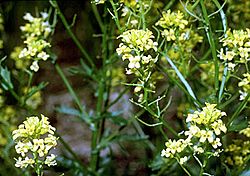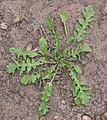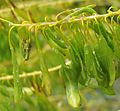Brassicaceae facts for kids
Quick facts for kids Brassicaceae |
|
|---|---|
 |
|
| Winter Cress (Barbarea vulgaris) | |
| Scientific classification | |
| Kingdom: | |
| Division: | |
| Class: | |
| Order: | |
| Family: |
Brassicaceae
|
The Brassicaceae is a family of plants. You might know them better as the mustard family or the cabbage family. This important plant group includes many vegetables and spices we eat every day.
Some famous members of this family are mustard, wasabi, and horseradish. These plants often have a strong, spicy flavor. Other well-known plants in this family include cabbage, broccoli, and cauliflower.
The flowers of Brassicaceae plants are quite special. They usually have four petals arranged in a shape that looks like a cross. This is why the family was once called Cruciferae, which means "cross-bearing." The name Brassicaceae comes from the main genus in the family, called Brassica.
Contents
Important Plants in the Brassicaceae Family
This plant family gives us many different foods. Some are used as spices because of their strong, hot taste. Others are popular vegetables that are good for you.
Vegetables from Brassicaceae
Many of your favorite vegetables come from this family.
- Cabbage: A leafy green or purple vegetable often used in salads or cooked dishes.
- Broccoli: A green vegetable with a tree-like shape, known for its florets.
- Cauliflower: Similar to broccoli but with a white, dense head.
- Turnips: Root vegetables that can be eaten cooked or raw.
- Radishes: Small, crunchy root vegetables often added to salads.
Spices and Flavorings
Some Brassicaceae plants are famous for their strong flavors.
- Mustard: The seeds are ground to make mustard sauce, a popular condiment.
- Wasabi: A very spicy green paste often served with sushi.
- Horseradish: A root used to make a pungent sauce, often served with meat.
How Brassicaceae Plants Grow
These plants can be found all over the world. They grow in many different climates. Many of them are annuals, meaning they complete their life cycle in one year. Others are biennials (two years) or perennials (many years).
The seeds of many Brassicaceae plants are very small. They often grow quickly. Farmers grow large fields of plants like rapeseed (a type of Brassica napus) to make oil. This oil is used for cooking and other products.
Image gallery
-
Incised leaves of Capsella bursa-pastoris
-
Corymbs of Arabidopsis thaliana
-
Siliquae of Cardamine hirsuta
-
Loment-like siliquae of Raphanus sativus
-
Cabbage (Brassica oleracea)
-
Turnips (Brassica rapa)
-
Rapeseed field in Germany (Brassica napus)
Images for kids
-
Smelowskia americana is endemic to the midlatitude mountains of western North America.
See also
 In Spanish: Brasicáceas o crucíferas para niños
In Spanish: Brasicáceas o crucíferas para niños
















